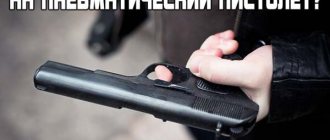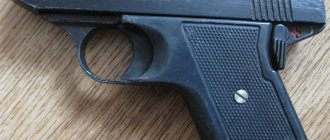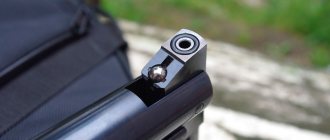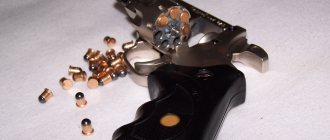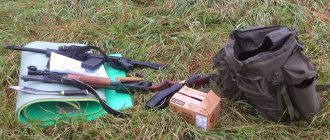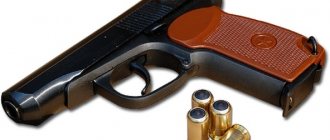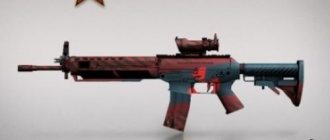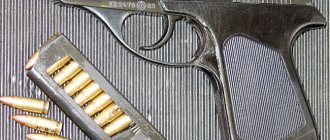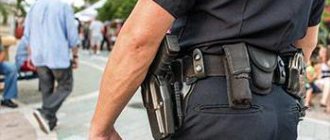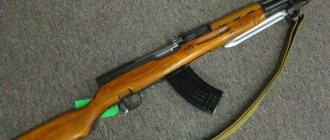When choosing an air rifle or pistol for sport shooting or hunting, you need to know the rules for purchasing, storing and using this type of weapon, as well as responsibility for violating these rules.
A pneumatic weapon is a weapon designed to hit a target at a distance with a projectile that receives directional movement due to the energy of compressed, liquefied or solidified gas (Article 1 of the Federal Law of December 13, 1996 No. 150-FZ “On Weapons”).
Pneumatic weapons are classified by muzzle energy and purpose, depending on which different rules for their acquisition, storage and use are established. For example, you do not need to obtain a license to purchase an air pistol with a muzzle energy of up to 7.5 J and a caliber of up to 4.5 mm. Liability for violating these rules also depends on the type of weapon.
It should be understood that caution must be exercised even when shooting from a product that is structurally similar to a pneumatic weapon, which can be freely purchased without any permits. If you injure a person with this weapon, cause damage to someone else's property, or shoot at animals and birds, you may be subject to civil, administrative or criminal liability. For example, for shooting at animals, resulting in their death or injury, a penalty may range from a fine of no more than 80,000 rubles to imprisonment for up to two years under Art. 245 of the Criminal Code of the Russian Federation.
Owners of more powerful pneumatic weapons with muzzle energy of 3 J or more must comply with additional restrictions. They are prohibited from shooting within populated areas, with the exception of shooting ranges and shooting ranges specially designed for this purpose, and for violation of this rule serious administrative liability is established under Art. 20.13 Code of Administrative Offenses of the Russian Federation.
It should be noted that special requirements are imposed on the creation of special places for shooting and established judicial practice confirms the need to obtain special permission for this. Thus, in the decision of the Altai Regional Court dated May 24, 2013, in case No. 4a-233/2013, it was stated that specially designated shooting areas mean shooting ranges and shooting ranges opened with permission from internal affairs bodies. The court emphasized that an earthen quarry located within the boundaries of a populated area and actually used as a shooting range does not qualify as such. Thus, it will not be possible to independently equip a special place for shooting at your dacha.
In what cases is a license required to purchase pneumatic weapons, where can they be fired, and what kind of liability faces the owner of a weapon who violates the established rules, find out from our infographics.
Click on the picture to enlarge
| Related documents: | Related news: |
|
|
Pneumatic classification
Before we begin to understand whether the owner of an air pistol is allowed to transport weapons in a car, let's first understand how pneumatics are usually classified. After all, many owners do not even suspect that their pistol or rifle does not fall under the definition of “air gun.” All models are divided into three categories:
- Shot power is up to 3 J. Such pneumatics are used mainly for recreational shooting or airsoft and are not considered by the “Weapons Law” as a weapon. Such a pistol is closer to a toy and practically does not cause any harm to human health if it is shot. Even a teenager can purchase such a model, and will not need to present any licenses or certificates. Most popular air pistols, as well as budget class models (MP-654K, Glock, Stalker) fall into this category.
- Shot power is from 3 to 7.5 J. These models are considered by the “Weapons Law” as examples of “civilian weapons”. Despite the fact that a shot from such a pistol can cause serious harm to health, almost any adult citizen can purchase it without presenting certificates of mental health and various documents giving permission to purchase. However, due to the fact that when using such pneumatics, a person bears a certain responsibility, it is not very popular among buyers.
- Shot power from 7.5 to 25 J. The most powerful category of pneumatic weapons, which can only be purchased with a certain license (hunter’s ticket, athlete’s passport, etc.). Appearing with such weapons in public places is tantamount to putting your freedom and material well-being at stake. However, this does not mean that a pistol cannot be transported from home to a shooting range or hunting grounds. The most important thing is to follow the transportation rules and have all the necessary documents with you, and then no problems with the law will arise.
As for weapons whose power exceeds 25 J, they are strictly prohibited on the territory of the Russian Federation and are not allowed for sale.
Of course, it is prohibited to transport such pneumatics in a car even in a completely discharged state, since storage is prohibited. Well, you will learn about the rules for transporting pistols from the three permitted categories in the following sections.
Do you need a permit for an airsoft gun?
Many users, before purchasing, wonder about permission to purchase airsoft weapons. Is it necessary? What procedures for wearing, transporting and using must be followed so as not to break the law and not attract the attention of the police?
The rules for the purchase, storage, use and transportation of such products are regulated by Federal Law No. 150-FZ “On Weapons”. Based on its concepts, as well as the unspoken rules of the airsoft community, we will answer the most pressing questions.
Is it possible to transport an air pistol in a car?
Now let's figure out whether it is possible to transport pneumatic weapons in a car, because it is no secret that owning pneumatic weapons implies the need to transport them from point A to point B. In short, yes, pneumatic weapons can be transported. However, this must be done according to certain rules, otherwise there is a huge risk of incurring administrative or criminal liability. Of course, these rules apply only to the second and third classification categories, since pistols up to 3 J are not considered weapons at all, and pneumatics above 25 J are simply prohibited by Russian law. Well, so that the traffic police officer does not suspect that he is being deceived, be sure to carry with you not only the passport for the pistol, but also the box in which it was sold when you purchased it.
Rules for the use of air guns
It is permissible to use pneumatics in two areas.
So, according to Art. 3 of the law in question, the use of the specified type of equipment is allowed:
- in sports, for example, shooting at paper or cardboard targets;
- For the purpose of hunting, as previously mentioned, small animals and birds.
Where can you shoot with pneumatics: is it possible to shoot in a city or town
Based on the norms provided for by administrative legislation, shooting with pneumatic guns is permitted only in those places that meet safety conditions.
Such places are considered:
These places must belong to organizations that have received permission from municipal authorities and that comply with the developed safety rules.
Requirements for storing weapons in a car
So, now that we have figured out that it is still possible to transport pneumatic weapons in a car, let’s find out how to do it correctly so that a law enforcement officer does not have any complaints against you. Here is a list of basic rules that must be followed:
- It is allowed to transport the pistol only in disassembled condition. That is, the store must be located separately from the weapon. It is also recommended to remove the spring, gas cylinder, PCP mechanism or any other source of energy from the weapon. In this case, the traffic police officer will not have any questions at all, and he will simply tell you: “Everything is fine. Bon Voyage". However, if you do not want to once again assemble and disassemble the pistol, then you do not have to follow this recommendation - it is not mandatory.
- Bullets or balls should be in a separate container. Most often, this role is played by the box or jar in which they are supplied for sale. In this case, the traffic police officer will be able to see what kind of cartridges you are using and for what purpose they are intended (all the necessary information is written on the box). Of course, it is strictly forbidden to equip even a detached magazine with cartridges, much less load the barrel with a bullet - such actions are considered an administrative offense and are punishable by a fine.
- The pistol must be in a visible place. On the Internet you can come across articles that say that a special holster or bag is needed to transport pneumatic weapons - this is not true. In fact, you can even transport an air pistol in the glove compartment if it is disassembled. And where you definitely shouldn’t store the barrel is under the seat or in a secret compartment in the trunk. If a law enforcement officer finds a weapon in such a place, he may have a number of unpleasant questions for you.
This concludes the basic rules for transporting pneumatics. Regardless of what power the gun has (5 J or 25 J), these points are strictly required to be observed. Now let's talk about the list of documents that the owner of a pneumatic gun must present if he is stopped by traffic police officers.
Rules for transporting weapons across the country
Firstly, guns must be unloaded during transportation and the clip must be removed if possible. This is argued by the fact that when the car hits a hole or any other unevenness in the road, a strong push can cause the trigger to spontaneously release. This can cause damage to the car and frightening the driver and passengers, as well as a serious accident.
Secondly, when transporting a weapon, it must be in a case, no matter what it is. You can use any, but it is better to purchase certified holsters, cases or boxes. It is also possible to purchase a car gun safe that best meets safety regulations. The main thing is that any means for storing and transporting hunting weapons has valid factory certificates and other documents. This is necessary so that when a vehicle is stopped by traffic police officers, they do not have any complaints, and the person transporting the equipment does not have problems with the law.
Thirdly, cartridges must be transported in original packaging or in special plastic boxes that can be purchased at a gun store. They cannot be transported in containers where they come into contact with each other (backpacks, bags, etc.). If a gun safe is used, then we can assume that the safety of the driver and passengers is ensured at the highest level, because These safes have special compartments for ammunition. As for knives and any bladed weapons: they are transported exclusively in cases for the safety of both the driver and passengers. If a person is going to transport gas or traumatic weapons to another region of the Russian Federation, then he needs to have a transportation permit.
Please note that one person can transport no more than 5 guns and 400 rounds of ammunition at a time.
If the quantity of one of them exceeds the norm, then additional rules must be followed:
- Accompaniment in the form of a group of 2 or more persons armed with firearms who have permission for such activities.
- Coordination with law enforcement agencies of the planned route and vehicle.
What must a driver show when transporting firearms?
So. Let's say that a traffic police officer stops you and asks if you have anything prohibited in your car. There is no need to evade the answer, but it is best to immediately say that you have an unloaded air pistol in the trunk or glove compartment. Most likely, the inspector will then conduct an inspection and also ask for the following documents:
- Weapons passport (comes with the pistol). It contains the serial number of the weapon, as well as a table with technical characteristics. It must be with you if you go somewhere, taking a pistol with you.
- A hunter's ticket, an athlete's passport or any other document confirming that you really need an airgun with a power of more than 7.5 J. Also be prepared to answer a question like: “Which side is the forest?” or “How to get to the nearest shooting range?”
- Certificate of mental health status. Usually issued upon receipt of a permit to purchase weapons. It is not necessary to carry it with you, but practice shows that such a document turns out to be very useful in negotiations with a law enforcement officer.
In addition to the listed documents, you will also have to present a driver’s license and a photocopy of your passport (or the original) in order to confirm your identity and registration (weapons are not sold to citizens without registration). If at least one of the documents is missing, the traffic police officer may detain the owner of the pneumatic until all the circumstances are clarified.
Let's move on to the law
Again, we will consider our favorite law on weapons - No. 150 - Federal Law (of course, the latest edition). What does he tell us?
We look for “ article 1 ” and determine what it is, quote:
“A pneumatic weapon is a weapon designed to hit a target at a distance with a projectile that receives directional movement due to the energy of compressed, liquefied or solidified gas.”
However, nothing is said here about what and what you can carry with you and what you can’t, and how this is regulated. Therefore, we are looking further!
Article 6 . Answers all our questions. It is called “Restrictions established on the circulation of civilian and service weapons.” That is, what is described in it does not need to be done! So, two points:
Point 2.
“storage or use outside of sports facilities of sports firearms with a rifled barrel, sports pneumatic weapons with a muzzle energy of more than 7.5 J and a caliber of more than 4.5 mm, sports cold bladed and throwing weapons, with the exception of the storage of long-barreled sports firearms with a rifled barrel or sports long-barreled pneumatic weapons with a muzzle energy of more than 7.5 J and a caliber of more than 4.5 mm, purchased by citizens of the Russian Federation in accordance with Article 13 of this Federal Law, storage and use of bows and crossbows for carrying out research and preventive work related with immobilization and injection of objects of the animal world (clause as amended, put into effect on June 15, 2010 by Federal Law of May 31, 2010 N 111-FZ"
Clause 2.1.
“carrying and transporting pneumatic weapons in a loaded or equipped state within the boundaries of populated areas, as well as the use of such weapons within the boundaries of populated areas outside premises and areas of terrain specially adapted for sports shooting in accordance with the requirements established by the federal executive body exercising the functions of development and implementation of state policy and legal regulation in the field of physical culture and sports, and agreed with the federal executive body exercising the functions of developing and implementing state policy and legal regulation in the field of internal affairs (item additionally included from July 1, 2011 Federal Law of December 28, 2010 N 398-FZ)"
For those who still don’t understand, I’ll explain it in simple and intelligible language.
First , in Russia, weapons with a muzzle energy of more than 7.5 J are generally prohibited. Only athletes are allowed, and only for competitions, etc.
Secondly , it is prohibited to carry or transport in a car any loaded pneumatic weapon, even if it is less than 3 J. That is, it must be unloaded, the “projectile receiver” removed, the compressed air canister unscrewed, etc.
I think it’s becoming clear!
How to export and import weapons across the Russian border
The activities of a professional hunter or sportsman often mean that the owner of a pneumatic gun needs to cross the border in order to get to a competition or hunting grounds located in another country. However, many people are afraid to carry a gun in their car through customs because they fear they will be detained for possessing a prohibited weapon. There is no need to worry, because if you have the entire list of documents listed with you, and the weapon is stored correctly, then no complaints should arise.
You can also hear from many “experts” that in order to transport weapons abroad, you must first obtain permission from the traffic police. We hasten to dispel this myth: law enforcement agencies are not involved in issuing such permits and other certificates. All that is required from the owner of the pneumatic gun is to warn the customs officer that you have a pistol or rifle in the trunk. After this, a police officer will be invited to the checkpoint, after which the car and documents will be searched.
Bottom line
An airsoft pistol or machine gun is not a weapon and its handling is not regulated by law. But you should remember that airsoft samples look like real ones and also shoot. Therefore, it is necessary to handle pneumatics carefully, without ignoring common sense.
Using simple rules of behavior, you will never get yourself into trouble and will be able to fully enjoy this type of hobby like Airsoft!
© Airsoft Planet, 2020 Partial or complete copying and publication of material without attribution is prohibited.
Actions of traffic police officers
It will be useful for a person who decides to move an air pistol from one place to another for the first time to learn about what actions to expect from a traffic inspector. Of course, a lot depends on the person’s competence, but in most cases he acts according to a certain algorithm:
- The inspector introduces himself and presents his identification (if the citizen requests it).
- The traffic police officer asks to see your driver's license and car insurance.
- This may be followed by a question about whether there is anything prohibited in the car.
- The inspector may ask you to open the trunk or glove compartment (if the driver refuses, the police will conduct a search in the presence of two witnesses).
- A traffic police officer will inspect weapons and ammunition for compliance with storage rules.
- The inspector will ask for documents and check the serial number of the weapon.
- If everything is in order, the policeman will release the citizen and wish him a good journey.
Of course, sometimes you come across not very competent inspectors who, during an inspection, begin to threaten a citizen, allegedly he violated Article No. 150 of the Criminal Code of the Russian Federation. It is worth showing restraint and calmness if you know for sure that you have not violated anything. If the police officer continues to behave unlawfully, then you can record everything on your phone camera - the law allows this.
When do you need a license and how to get it
Now let's take a closer look at when a car driver may be required to present a license to use pneumatics, as well as how to properly obtain one. So, this document is required only if the power of the air pistol exceeds 7.5 J. You can obtain a license as follows:
- By registering in the register of hunters and receiving a hunting license. In this case, the person will receive permission to purchase pistols used for hunting. However, before this you will need to pass an exam (theory) about in which places hunting can be carried out and when it is allowed to shoot certain types of game. A certificate of mental health status will also be required.
- Get an athlete's passport. Makes it possible to use pistols intended for training and sports shooting. You can only obtain a document if you join a sports association. In addition, you will also need to obtain a certificate from the trainer that you really need a new weapon to participate in competitions or hunt.
These documents give a citizen the right to purchase weapons for specific purposes, so when transporting a pistol with a power of more than 7.5 J, you should prepare for the fact that the inspector will have to answer some questions. And most importantly: not a word about self-defense! Civilian weapons are in the 3 to 7.5 J category and do not require a license.
Responsibility for violating the rules
We should not forget that every citizen is endowed not only with certain rights, but also with responsibilities, failure to comply with which may result in administrative or criminal liability. Here are some examples:
- For violating the rules for transporting weapons, a fine of 3 to 5 thousand rubles is imposed, and the pistol or rifle is confiscated by a law enforcement officer. If a citizen is unable to pay the fine within the prescribed period, the court may order him to undergo correctional labor.
- Transporting weapons without a license entails a more serious punishment - a fine of 10 to 30 thousand rubles, confiscation of the weapon and revocation of the license (if one existed but was not presented), as well as a ban on the purchase of pneumatic weapons for a period of 3 years. As an alternative, you can choose several months of correctional labor.
- Criminal liability arises only if improper transportation results in damage to the health of one of the passengers or passers-by. For such an offense, a person may face imprisonment for up to 7 years, as well as an indefinite ban on carrying pneumatic weapons.
The penalties for offenses are quite serious, so compliance with the rules for transporting pneumatics should be taken very seriously. Otherwise, you risk not only not seeing your favorite pistol again, but also losing your freedom.
Thus, any owner of a pneumatic gun has the right to transport his weapon in a car if he has all the necessary documents, and also fully complies with the transportation rules prescribed in the “Weapons Law”. In addition, citizens with hunting or sporting models can also transport their arsenal across the border. The most important thing is not to be afraid to explain the situation to a customs or traffic police officer, and to strictly follow the law.
